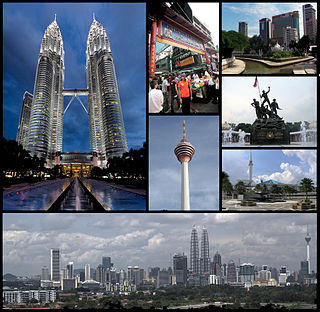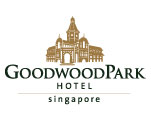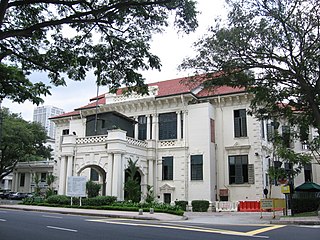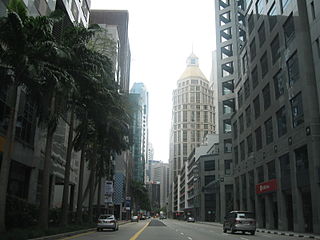The year 1899 in architecture involved some significant events.

Raffles Place is the centre of the Financial District of Singapore and is located south of the mouth of the Singapore River. It was first planned and developed in the 1820s as Commercial Square to serve as the hub of the commercial zone of Singapore in Raffles Town Plan. It was renamed Raffles Place in 1858 and is now the site of a number of major banks. It is located in the Downtown Core within the Central Area, and features some of the tallest buildings and landmarks of the country.

The Padang is an open playing field located within the Downtown Core of the Central Area in Singapore. It includes the Padang Cricket Ground. The Padang is surrounded by several important landmarks, which include Saint Andrew's Cathedral, City Hall, the Old Supreme Court Building and the City Hall MRT Station.
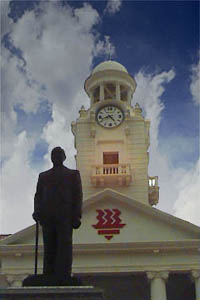
The Chinese High School Clock Tower Building is a gazetted national monument in Singapore is situated in the campus of the integrated Hwa Chong Institution, which incorporates The Chinese High School and Hwa Chong Junior College.

The Armenian Church of Saint Gregory the Illuminator, referred to locally as the Armenian Church, is the oldest Christian church in Singapore, located at Hill Street in the Museum Planning Area, within the Central Area. The church was completed in 1835 and consecrated the next year. Originally a parish of the Armenian Apostolic Church, an Oriental Orthodox denomination, the last Armenian parish priest left in the late 1930s as Armenian population in Singapore dwindled. It was designated as a national monument in 1973. Armenian and Oriental Orthodox services are now regularly held at the church.

CHIJMES is a historic building complex in Singapore, which began life as a Catholic convent known as the Convent of the Holy Infant Jesus (CHIJ) (圣婴女修院). The complex is located at Victoria Street in the Downtown Core, within the Central Area, Singapore's central business district.

George Drumgoole Coleman, also known as George Drumgold Coleman, was an Irish civil architect who played an instrumental role in the design and construction of much of the civil infrastructure in early Singapore, after it was founded by Sir Stamford Raffles in 1819. Only a few of his buildings have survived in Singapore, most notably Armenian Church of Saint Gregory the Illuminator, Maxwell's House, and Caldwell House.

The National Museum of Singapore is the oldest museum in Singapore. Its history dates back to 1849, when it was started as a section of a library at Singapore Institution and called the Raffles Library and Museum. After several relocations, in 1887 it moved to its permanent site at Stamford Road in the Museum Planning Area.

Beach Road is a road located within the planning areas of Kallang, Rochor and the Downtown Core in Singapore.

The Majestic is a historic building on Eu Tong Sen Street in Chinatown, Singapore. Located between the People's Park Complex and Yue Hwa Building, it was known as Majestic Theatre, which was a Cantonese opera house.

Stamford House is a historic building located at the corner of the junction of Stamford Road and Hill Street, in the Downtown Core of Singapore. Originally known as Oranje Building, it formerly housed a shopping mall. The building had since redeveloped along with adjoined Capitol Building and both were reopened as a hotel The Capitol Kempinski Hotel Singapore in October 2018.

Yue Hwa Building is a historic building located at the junction of Eu Tong Sen Street and Upper Cross Street in Chinatown, Singapore. Built by Swan and Maclaren in 1927, it was then the tallest building in Chinatown and was known as Nam Tin Building (南天大厦), owned by Lum Chang Holdings. The building housed the six-storey Great Southern Hotel, along with a few shops and cabarets that were popular among Chinese travellers. In 1993, Lum Chang Holdings sold the building to Hong Kong businessman Yu Kwok Chun, who converted it to the first Yue Hwa Chinese Products department store in Singapore in 1994. The renovation process, which conserved the exterior while adding features such as an atrium and waterfall to the interior, won the building the Architectural Heritage Award by the Urban Redevelopment Authority in 1997.
Arthur Benison Hubback was an English architect and soldier who designed several important buildings in British Malaya. He was active in sports, especially football and cricket. Hubback was promoted to brigadier general during his service in the British Army.

Kampong Kapor Methodist Church is a Methodist church located on Kampong Kapor Road in Singapore's Little India district. The church is approximately 300 metres from Jalan Besar MRT Station.

The Fullerton Waterboat House, originally known as the Water House, was formerly a historic water supply house used to supply fresh water to incoming ships in Singapore. The former Water House was gazetted for conservation in 2002 and has since reopened as a restaurant.




